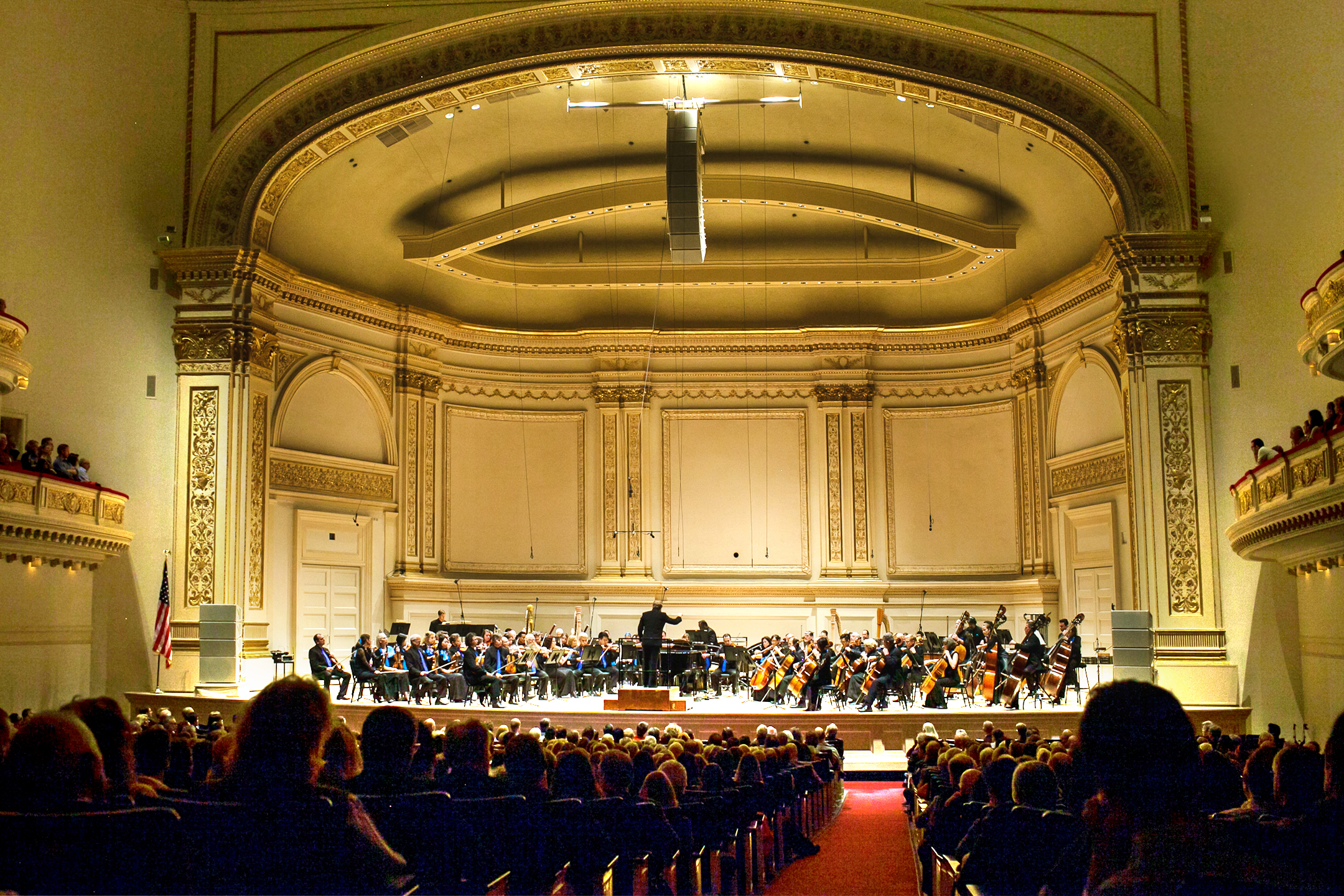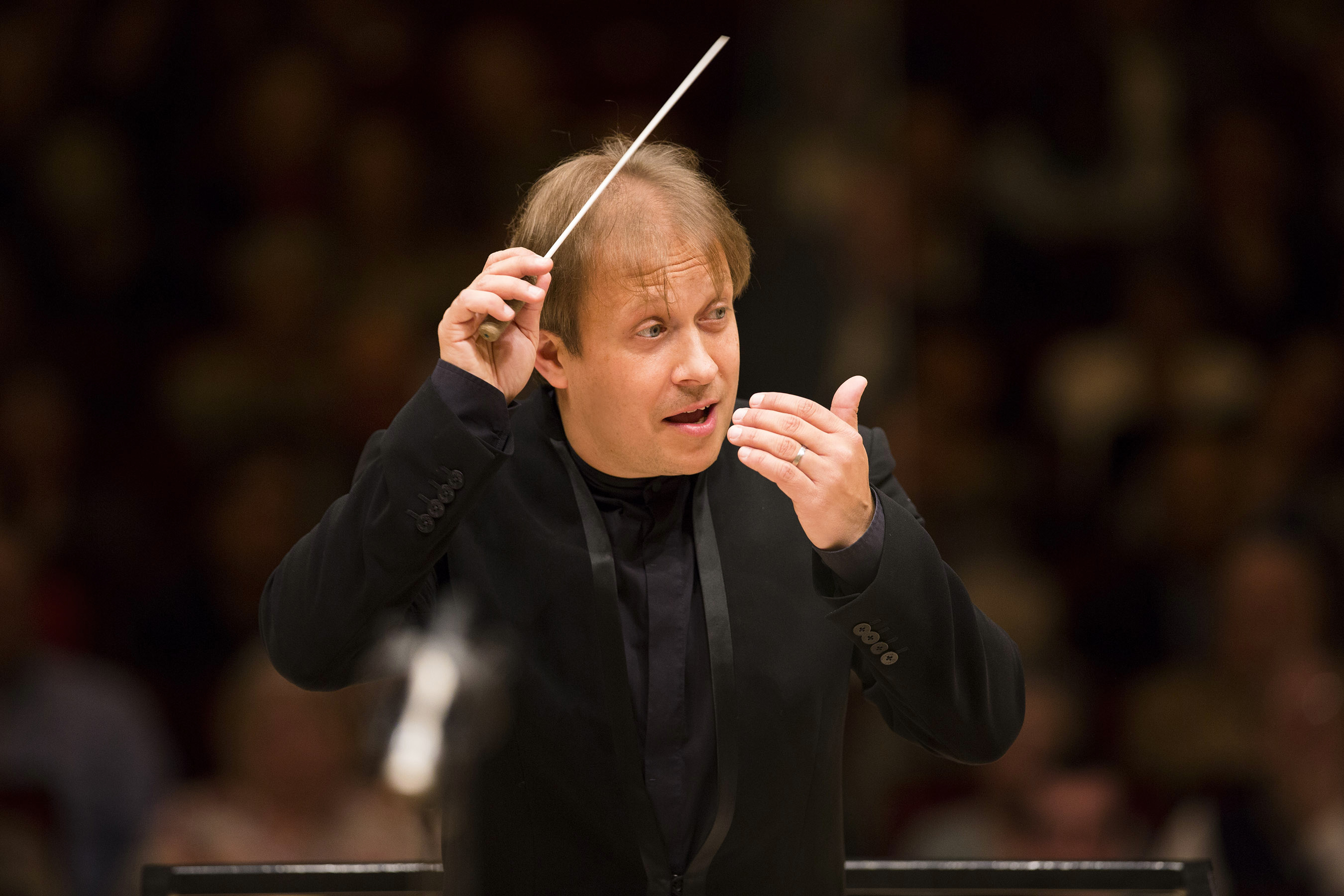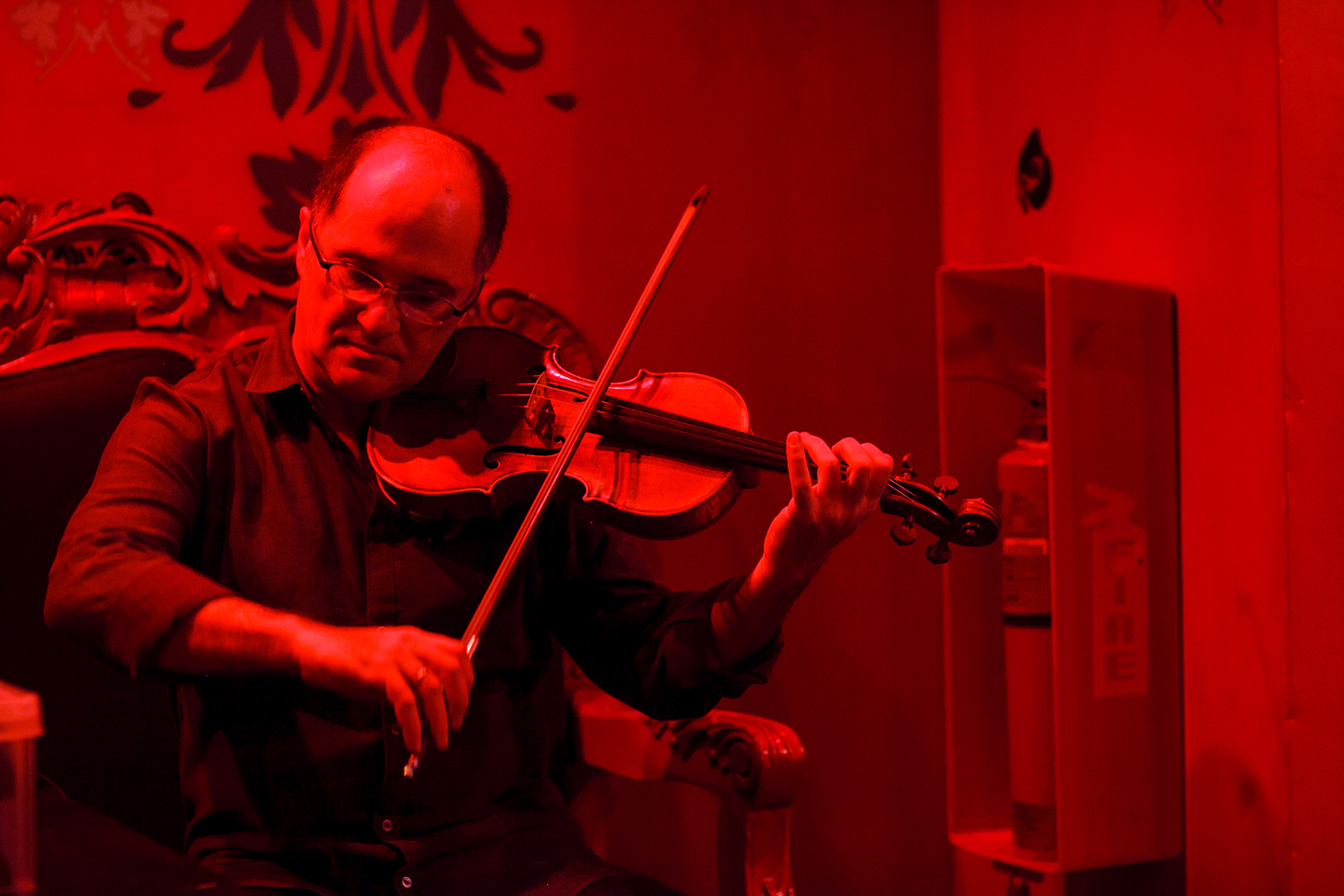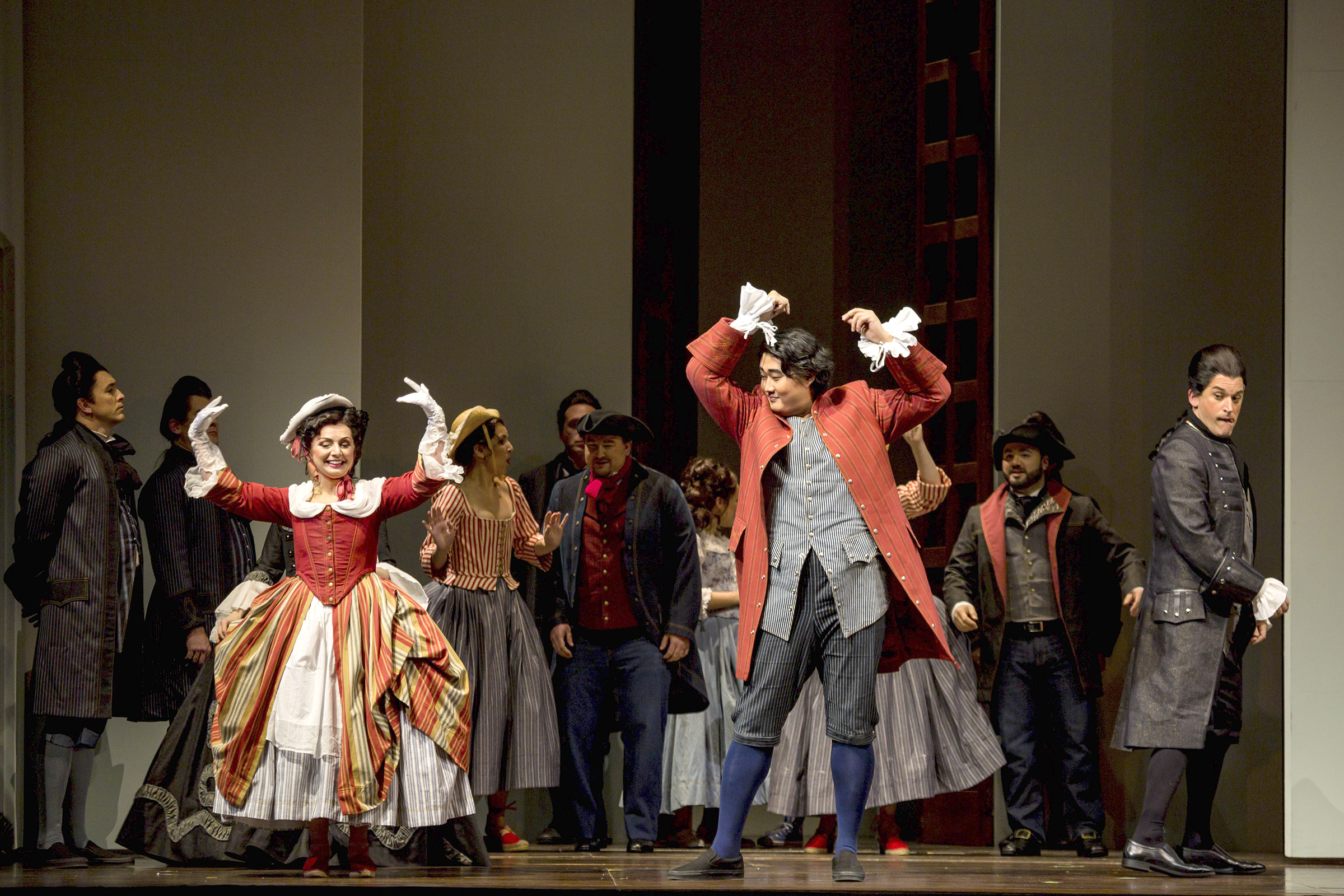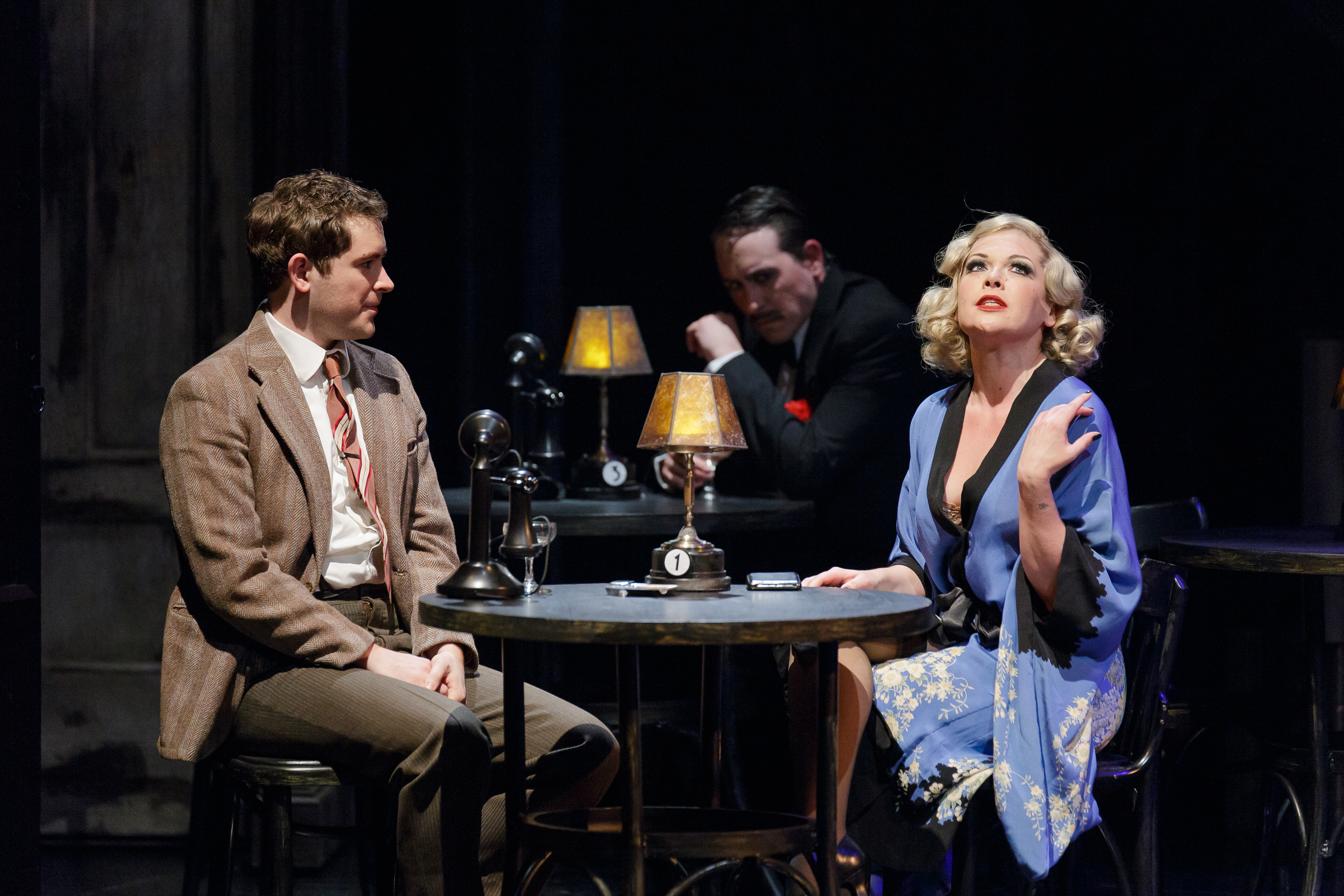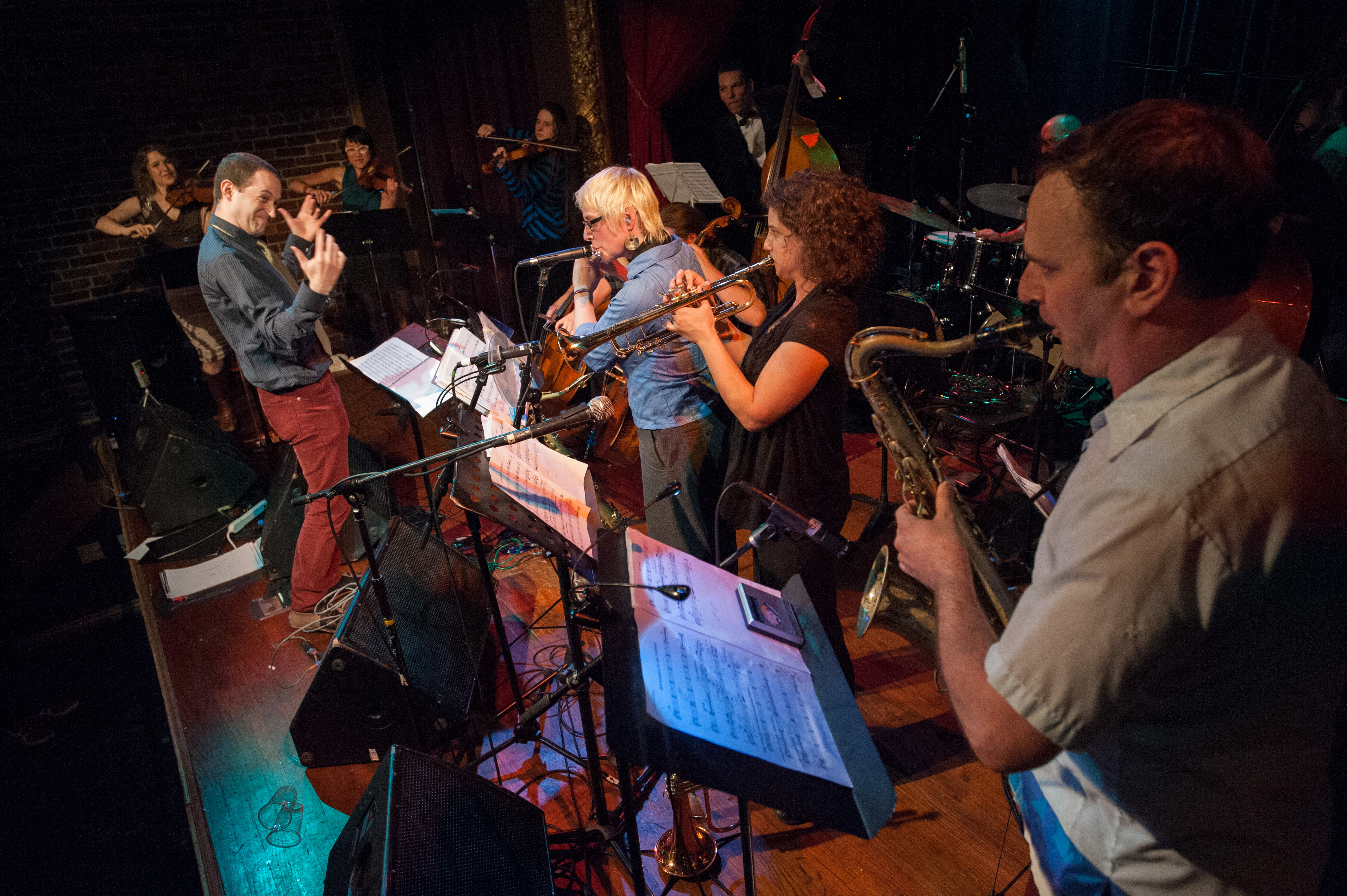Monday, May 5
8 a.m., Benaroya Hall
Orchestra players’ careers depend on punctuality—you’re in your seat ready to go when the baton drops, or else. So it’s no surprise that the three buses lined up outside Benaroya Hall on Gerard Schwarz Place pull away at the exact scheduled time and head toward Sea-Tac Airport. Seattle Symphony music director Ludovic Morlot and a few other musicians left for New York City yesterday; the rest of the orchestra—and plenty of family members, support staff, and press, 158 bodies in all—is traveling now to meet with its leader before playing a Tuesday-night concert of music by Debussy, Varese, and John Luther Adams at Carnegie Hall as part of the Spring for Music festival.
At the airport, cellist Efe Baltacigil totes his instrument on his back, like a guitar-playing gunslinger in an old Western. Violinist Cordula Merks and her toddler daughter Mia are dressed alike in matching red-and-white pinstriped tops. Check-in and security lines seem to be running at prime efficiency, so as we gather at the gate to take off at about 10:30 a.m., the mood is stress-free—enhanced by the complimentary beverages on this five-hour chartered flight, including, festively, Champagne in little plastic coupes. For lunch, orchestra members and their entourage can choose between lasagna with green beans or chicken breast with mashed potatoes. Amazingly, there are metal utensils (what is this, 1960?) and cloth napkins (who am I, Frank Sinatra?). Losing three hours while flying east means the travel takes most of the day. Dusk approaches as we board the buses at John F. Kennedy International and begin traversing the unhandsomest parts of Queens on our way to midtown.
The bus arrives at the Empire Hotel near Lincoln Center, a surprisingly Vegassy place with gold fixtures and big-cat-patterned upholstery. Most of the orchestra is staying here, but I’ve arranged other lodgings even closer to Carnegie Hall. Our packed agenda—roughly 43 and a half hours between touchdown and takeoff at JFK—leaves me just enough time to check in and drop my bag before subwaying downtown for tonight’s bonus concert.
10 p.m., Le Poisson Rouge, 158 Bleecker St.
Tucked among a maze of narrow streets near Washington Square, where there’s a bar or restaurant every 15 feet and everyone is half my age, Le Poisson Rouge presents intimate new music of all kinds, with a gratifying emphasis on contemporary classical. John Zorn played here just the night before, and an upcoming piano recital pairs music by Domenico Scarlatti and John Cage. The place is tiny, packed, and dark, with black walls and columns. You can imagine Blondie performing here, or Lou and Laurie, or a fringe-theater production of Hedwig and the Angry Inch.
I don’t know that any of the five other Spring for Music orchestras set up a side gig like this—an export of the SSO’s late-night “Untitled” concerts in the Benaroya Hall lobby. It’s perhaps Morlot’s most exciting new idea in the three seasons he’s been in charge, not least for the new audience members it’s drawing. The program fits even better in this space. There’s a recent notion that it’s oppressive and off-putting to expect concertgoers to actually pay attention to music; the Cincinnati Symphony, for example, has experimented with designated Twitter sections for concertgoers who can’t keep their thumbs off their phones even for half a concert. Not so here. The crowd, even in this unorthodox, supposedly more casual environment, is nearly silent by choice—the pulling of taps and the opening of cans are the only ambient sounds, and they punctuate, rather than disrupt, the music.
Of the program’s six pieces, three are by composers the orchestra will play tomorrow at Carnegie Hall. First up are Claude Debussy’s delicately chiming, jasmine-scented “Pagodes” for piano and Varese’s Density 21.5 for solo flute, which shape-shifts back and forth between craggy drama and melancholy Debussyan lyricism.
John Cage’s Imaginary Landscape #1 follows. Written in Seattle during the composer’s two years on the Cornish College faculty back in the late ’30s, it’s before its time: Decades prior to turntabling’s ascent as a performance art, Cage was experimenting with vinyl recordings of sine waves and other broadcast test tones, changing the records’ speeds to fluctuate their pitch, Theremin-style. For this piece he combined two turntables with a Chinese cymbal and a piano, asking the pianist to mute it by pressing a hand directly on the strings; the resulting quiet, sonorous thumps are arranged in melodic lines that obsessively stick to a two- or three-note range.
Up next is Vladimir Nikolaev’s vnik-ton experience, a beguiling collage of innocuous bubbliness, like an NPR music bumper, and theatrical glam-rock gestures both musical and visual. Its closing flute/clarinet duet strongly evokes, of all composers, Copland.
Closing the evening is Adams’ sextet The Light Within, which, cellist David Sabee remarks from the stage, is meant to evoke “the push of the Northern Lights, the groaning of the earth” with ripples of piano over steady-state washes from everyone else. But it’s a bit hard-edged, and the “light” feels like the blinding glare of noonday sun on snow. It’s a bowl-shaped piece: crepuscular in the middle, brighter at either end, brilliance shading into harshness.
Adams is not the only living composer the SSO is bringing to New York. Angelique Poteat, an alumna of the SSO’s Young Composers Workshop and today a freelance composer and clarinetist in Seattle, was invited in December to write something especially for this Poisson Rouge concert. The result, Much Difference, was inspired by, and is sort of a response to, Pearl Jam’s “Indifference.” From that iconic band, Poteat drew a measure of aggressiveness and rawness, mixing in touches, to my ears, of Samuel Barber ear-friendliness and free jazz, and giving each musician plenty of scope for solo expression. “They totally jumped on that,” she says of her rehearsal time with the SSO players. Poteat was thrilled with the response from the Poisson Rouge audience. “Everyone said they were having so much fun,” she says of the performers’ energy.
Much Difference already has a busy future. It will be played at a SSO fundraiser at the Chihuly Boathouse on May 31—with Pearl Jam guitarist Mike McCready expected to attend to hear the music he inspired—and Poteat is expanding it into a work for full orchestra for next January’s installment of “Sonic Evolution,” the classical/rock cross-pollination concert series that has taken flight under Morlot.
The orchestra was notified of its invitation to Spring for Music in December 2011, and the planning for the trip began more than a year ago. It wasn’t easy, says Kelly Boston, the SSO’s director of operations. Because of a tight schedule, with most musicians slated to play for Seattle Opera’s Tales of Hoffmann on May 3, 4, and 8, there wasn’t enough time to get from coast to coast using the usual methods. Normally cargo for a tour like this would be trucked, and leave several days early; and cargo flights, it turned out, don’t operate Sundays and Mondays. Plan C was the charter plane, equipped with a climate-controlled cargo hold that contained 31 instrument trunks for all the large instruments and about half the smaller strings and winds (some players opted to take theirs as a carry-on), four for wardrobe, and one for sheet music, plus additional items like stools for the bass players.
Percussionist Rob Tucker tells me that Varese’s Deserts in particular requires a huge arsenal. Timpanist Michael Crusoe “ships his five timpani, but everything else has to be rented [in New York]—two five-octave marimbas, three bass drums.” He and the five other percussionists playing the Varese bring only small stuff, like beaters and tambourines, in four small boxes. Then they have to accustom themselves to all the new rented instruments in the single Tuesday-afternoon rehearsal that Carnegie Hall’s very full schedule will allow—not much more than a sound check.
It’s not an inexpensive program. In addition to all this extra percussion, the John Luther Adams piece requires four harps (two brought, two rented). Nor is it an uncomplicated one; the three pieces the orchestra will be playing use three different seating setups. One reason the SSO gave two preview performances of the complete Carnegie program (a late-March date in Portland and a send-off concert on May 2 at Benaroya), Boston says, was to give the stage crew a chance to practice the reshufflling. “I feel like [the whole tour] went off almost flawlessly,” she tells me later. “All the work we did was worth it. I think the orchestra is energized by it.” This New York visit itself is a dry run of sorts for the orchestra’s next big trip: a tour of Asia in 2016.
The $300,000 price tag for the trip was funded by donations and sponsorships, reports vice president of communications Rosalie Contreras. Going some way toward offsetting that is the $50,000 that Spring for Music guarantees each participating orchestra—or more, if they’re able to sell enough tickets. The Seattle Symphony’s concert will turn out to be one of the week’s successes; Contreras says, “We did clear the $50,000 box-office-receipt threshold by a small amount.”
Tuesday, May 6
2:10 p.m., Carnegie Hall,
881 Seventh Ave.
What is usually Carnegie Hall’s imposing facade is currently masked on three sides by scaffolding. Still, the window posters for the six Spring for Music orchestras are prominent: New York, Rochester, Winnipeg, Cincinnati, Pittsburgh, and us.
The Seattle Symphony has not received top billing here, yet The New Yorker’s Alex Ross called its concert “perhaps the most anticipated offering” in Spring for Music week. No surprise; just a few weeks ago, with timing that could not have thrilled the SSO more, Adams’ Become Ocean, which was commissioned by the orchestra and will be performed tonight, won the 2014 Pulitzer Prize for Music. The anticipation will surely get a further boost from today’s lavish New York Times profile on Adams (with two huge photos) by Corinna da Fonseca-Wollheim.
The SSO has a rehearsal scheduled for 2:30. I’d hoped to observe, but Morlot asked for no press—even those the orchestra invited along. Still, I hang around the stage door hoping to slip in, even though VP of Artistic Planning Elena Dubinets warns me the hall is “pretty tight on security.” Everyone else has badges and lanyards and other credentialish-looking things; it’d be too embarrassing to be caught and tossed out, so I give up.
The invitation to play at Carnegie is no small honor. The orchestra was one of more than 60 that submitted proposals. In the project’s fourth and final season (unless more funding is found), Spring for Music’s
goal is to provide, as its website puts it, “an idealized laboratory, free of the normal marketing and financial constraints, for an orchestra to be truly creative with programs that are interesting, provocative, and stimulating, and that reflect its beliefs, its standards, and vision.”
Morlot’s response to that mission statement—the program proposal that garnered the invitation—is built around Adams’ new piece; it includes three century-spanning works evocative of physical space, nature, and landscape, deliberately chosen to reflect Seattle’s interest in the environment.
For the 42-minute Become Ocean, which the SSO premiered last June, Adams divides the orchestra into three subgroups: strings, winds, and brass, spatially separated onstage, each joined by a handful of percussion, harps, piano, and celesta. In the top left corner of the first page of his score, where most any other composer would put a simple metronome marking or a tempo direction in Italian, Adams wrote the single word “Inexorable.” It suggests not only the work’s steady tempo, but the natural processes, outside of human control, that have inspired his approach to composition.
Captivating the audience at Benaroya Hall on May 2, just as it had the previous June, the piece opens on a foundation—like a sea bed, to extend the metaphor—of basses and bass drum. Quiet rippling in the piano, percussion, and harps keep the surface motion active; trombones and bassoons join the long-tone bottom layer of basses; the upper strings soon enter with murmuring figuration. Become Ocean’s breadth and serenity evokes, as Adams’ music often does, the spaciousness and grandeur of nature—specifically of Alaska, where he’s lived since 1978 and served as the state’s unofficial composer laureate.
Like the waves of the titular ocean, the three instrumental groups move independently, each rising and falling at its own pace, one surging while another is ebbing. Even the work’s overall shape is a wave—an immense palindrome, ending as it began with basses and bass drum. One particular sequence represents the kaleidoscopic nature of the whole: a gently piercing oboe note followed by the tinkle of four harps, rich deep growls in the brass, and the platinum gleam and shimmer of violins—each sound layered on the previous one, blending with or covering it.
About Deserts, Varese’s homage to the American West that’s second on the Carnegie program, Morlot once said, “What I love about this music is that many people don’t love it,” adding that it is about “capturing the isolation one feels.” If the piccolos in this stringless study recall sirens, certainly nothing else in it, from the gnarled brass fanfares to the rumblings from the percussion batteries on either side of the stage, feels urban. Deserts has its assaultive moments, but much of it evokes a sort of dusk-deepening calm; it’s music that’s indifferent to the listener rather than confrontational, like scurrying animals going about their twilight business. At the May 2 preview performance, there were audience giggles at some of the percussion effects—the whip, the xylophone glissando—and why not? “I try to be open-minded, but . . . not my thing,” the woman next to me admits, but plenty of lusty “Whoo!”s break through the applause.
Morlot has also compared Deserts to an Ansel Adams photograph—stark contrasts of black and white—with Debussy’s La mer, the program closer, more like a Turner. But to my ear, Morlot’s approach to the latter work is cleaner than that, his rhythms more pointed, his tempo nuances unfussy—everything the score asks for, of course, but nothing more indulgent. (“Misty music, to sound misty, must be played without mist,” composer Ned Rorem once said about Debussy.) The string tone is sweetly silken rather than lush. The one passage Morlot noticeably milks is the return of the big tune in the finale, bringing it a pang of nostalgia, but even this is offset by the acid tang of the high violin harmonics.
7:15 p.m.,
outside Carnegie Hall
“Mob scene” might be too strong a term, but there is a crush outside Carnegie’s front entrance before concert time. It’s apparently sold out; one hopeful attendee holds up an “I need a ticket” sign. I hope he got one.
I’m startled when I see a knot of SSO musicians—they’re wearing something new for the occasion. Spring for Music has specified no formal wear for the participating orchestras, and while the players are wearing black, they’re also outfitted with striking blue accessories: sashes for the women, who variously don them as belts, scarves, even headbands, and ties and pocket squares for the men. This look is the brainchild of Michael Cepress—designer, UW art instructor, and evangel for “wearable art”—and the true beauty of his concept is apparent only after the musicians take their seats onstage: The accessories were hand-dyed in shades from kingfisher to aqua and assigned to specific players, with an eye to the overall effect, depending on where each sits for Become Ocean.
“These are performers on a stage—why is wardrobe not being used as a part of the performance?” Cepress says the next day when I ask him about his innovative design. After working with Cepress on a 2012 holiday fundraiser, the SSO called him to devise something special for this concert. Could this finally mean the end of the tuxedo in Benaroya Hall? Excited about the possibilities of customizing looks for different SSO programs, he says, “It’s my hope that they adopt this approach.”
It’s a colorful spectacle, with Carnegie’s gold and cream interior an elegant backdrop for the touches of blue, as well as the few hundred hot-pink handkerchiefs distributed to the Seattle supporters who have traveled 3,000 miles for this evening. The program mentions 673 as the official count of hometown fans, but that was at press time; later, Contreras says it’s closer to 750; on the flight home, executive director Simon Woods says more than 800. After Board of Directors chair Leslie Jackson Chihuly rouses the audience—not many of the hall’s 2,800 red-velvet seats are empty—with a pep talk, concertmaster Alexander Velinzon enters; then Morlot takes the podium and gives the downbeat.
Unable to attend last summer’s premiere for medical reasons, Adams, astonishingly, is tonight hearing his Pulitzer-winning piece live for the first time. (He even missed this afternoon’s rehearsal thanks to an iCal glitch.) Asked later if anything about his music surprised him, he says, “It sounds more or less exactly as I imagined, which rarely happens,” but then reconsiders. “I was surprised by how beautiful it was,” he says, full of praise for the players. “I was amazed—within 30 seconds, the orchestra just picked me up and carried me away.”
He tells me that when he was first discussing this commission with Morlot, he had two proposals; the other was splashier, more in the line of his visceral, lapel-grabbing percussion piece Inuksuit (still unheard in Seattle). But Morlot opted for this one—a vast arc of growth and decay in which the moment-to-moment changes are subtle rather than dramatic. “What a leap of faith,” Adams marvels. “It’s a pretty audacious prospect, but somehow it works.”
Built in 1891, threatened with demolition in 1960, but saved and restored, Carnegie Hall symbolizes in American culture the top level of musical achievement across genres. Tchaikovsky conducted on opening night; Dvorak, Stravinsky, Ives, and Britten had symphonies premiered here; Duke Ellington, the Beatles, Bob Dylan, Patsy Cline, and Judy Garland played this stage. Tonight, thanks to the hall’s legendary acoustics, Become Ocean, to my ear, teems with more surface detail than ever: the ripples of the mallet instruments, the individual bow strokes that make up the strings’ glinting sheen. In La mer, the cellos have the warm shine of copper; the low-brass growls are earthier; there’s an extra intensity to the thunderclaps in the finale, a frantic brilliance to the trumpet fanfares. After the concert I ask violinist Mikhail Shmidt what it’s like to play there. “Benaroya is a great hall, but Carnegie has one extra layer of sophistication and—air,” he says, making a “blooming” gesture. Morlot agrees. Later that week on the phone, he calls Carnegie “more forgiving—more faithful to what you get when you sit in the audience . . . it’s a great hall to realize exactly what the orchestra sounds like—I learned a lot being on that stage.”
10 p.m., Carnegie Hall
The standing ovation, of course, is robust. The loudest cheers come from Carnegie’s top tier, traditionally the cheap-seat eyrie of students—except at Spring for Music, no seat costs more than $25. And the orchestra has an encore at the ready: more Debussy, the glittering “Fetes” from his tone-poem trilogy Nocturnes.
On the sidewalk outside the stage door, elated players greet listeners, hug family members, and snap photos. The after-party is next door at the Russian Tea Room. Its red-and-gold third-floor reception room makes Versailles look like an IKEA warehouse: six-foot-tall dancing bears in etched glass on the mirrored walls, and more bears on the three immense chandeliers which look like an explosion in an ormolu factory. Waiters pass with trays of raspberry tarts and teeny blini with caviar; the open bars hum; the buzz of exhilarated musicians and admirers reaches nearly a La mer volume level.
The critics are impressed. In the Times, Anthony Tommasini says of the Adams, “The performance Mr. Morlot coaxed from his players was rich with shimmering colors and tremulous energy. The engagement of the musicians with this work, and with Mr. Morlot, came through in every moment,” and of the Debussy, “the unusually bright, vibrant, and muscular performance Mr. Morlot drew from the orchestra [was] a bold approach to a familiar score.” New York’s Justin Davidson praised Become Ocean as an “utterly original, totally immersive sound world.”
All this is pleasant, but in a city as status-hungry as Seattle, one risks making too much of the “Now we’re somebody! ” aspect of the trip. This would be unfair to the orchestra, clearly a splendid group with or without New York’s approval. And for Morlot, what was important about this trip was what it meant for the Seattle Symphony’s relationship with its audience here. “The support was incredible if you think of how many people traveled from home,” he tells me later. “It means people understand where we’re at in the pattern of our growth, [and feel] a sense of accomplishment, of trust in what we’re trying to build.
“We went out there bringing some of the spirit we want to impart to our vision,” he says. Impressing New York was not the goal. Sharing—even pointing the way toward—what an orchestra can and should be in the 21st century was Morlot and the orchestra’s achievement. As Spring for Music puts it, “An orchestra’s fundamental obligation is to lead and not follow taste.”
gborchert@seattleweekly.com
The concert can be streamed via the website of radio station WQXR at wqxr.org.
